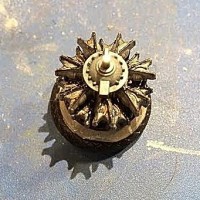Revell 1/32 Beaufighter
The origins of the iconic Beaufighter can be traced back in the late 30's where the Bristol Aeroplane Company recognised that its Beaufort torpedo bomber had the appropriate layout and structural strength to be quickly modified and reequipped with more powerful engines, in order to become an efficient fighter.
Replacing the Beaufort's Taurus engines with the more powerful but more heavy Hercules radials, required a shift of the plane's center of gravity backwards, something not that difficult to achieve by deleting the now unnecessary bomber position (and giving the Beaufighter its characteristic stubby appearance).
The pilot sat in a fighter-type cockpit, while the navigator-radar operator sat to the rear under a small Perspex bubble where the Beaufort's dorsal turret had been. Each member would enter the plane via his own hatch. Armament was located in various positions on the lower fuselage and wings, with the type being among the most heavily armed fighters of the time. The bomb bay of the Beaufort had been entirely omitted, but a small bomb load could be carried externally.
The initial skepticism regarding the ability of the Hercules engines to provide sufficient power, especially as extra equipment will be installed to the plane, together with the fact that the Hercules would also be needed for other important aircraft, such as the Short Stirling, led to the adoption of the Merlin XX as an alternative engine.
The plane was additionally developed as a fighter-torpedo bomber, using its firepower to suppress flak fire and hit enemy ships, especially escorts and small vessels. The recoil of the cannons and machine guns could reduce the speed of the aircraft by around 25 knots.
The Beaufighter found its niche as a night fighter. As early as during the Battle of Britain, it was available in good numbers by the time the first interception radars became available, with the plane's vacant nose and spacious fuselage providing ideal places to accommodate the radar antennas needed and the early, bulky aircraft interception equipment respectively.
Although emerging from a bomber and with its conservative aerodynamics somehow not favoring speed and maneuverability, the Beaufighter can be considered a highly successful plane, performing very well in its assigned roles, especially as a night fighter. Bristol's very wise decision to base it on the Beaufort, resulted in quickly mass producing the Beaufighter at the time it was needed the most.
Revell came in 1974 with a new tool 1/32 Beaufighter, reboxing it another 13 times ever since, the last reboxing having taken place in 2014. By all means an elderly, simplified but decent kit with a very nice decal sheet, it is still (as of 2024) your only option if you want to build a 1/32 Beaufighter.
https://modelingmadness.com/review/allies/gb/fighters/penbo.htm
Happy Modelling!

















Really fantastic!
Thanks a lot, my friend @lis!
Great story about the development of the Beaufighter, Spiros, and an equally great model. It must take up a lot of your display space.
Thank you kindly, my friend @chinesegeorge!
Yes, she is big!
How did you sneak this one in, Spiros (@fiveten). I had no idea that you were working on this. Well done. Lots of info I didn't previously know about the Beaufort and Beaufighter.
Thanks a lot, my friend @gblair!
Started many years ago, received final touches lately.
Spiros, that is really spectacular. Do you know why certain RAF types with radial engines had copper colored cowl rings? I have wondered about that for many years. I did see the article on Modeling Madness. I would never have guessed that such a nice result could come from this fifty year old kit.
Thank you kindly, my friend @russjurco!
Those cowl rings were exhaust collector rings, where the exhausts from the individual cylinders were "collected" there and safely discharged through he final exhaust duct. It was a feature of some radial engines.
This looks spectacular Spiros (@fiveten). Nice way to finish a long term build. For those interested, there are quite a number of aftermarket resin 3D printed parts available for this kit, although the total could add up to a fair amount of extra cost. I can't recall the name of the company at the moment, but the owner seems quite prolific.
Thank you very much, my friend @clipper!
Always a pleasure to read a good article and look at a older kit made to perfection.
Thank you kindly, my friend @stephen-w-towle!
Great to see Spiros@fiveten - nice work!
Thanks a lot, my friend @davem!
What a wonderful result, Spiros @fiveten
I was not aware you also had this one on your workbench. Great to see it on the headlines with a nice to read and informative article.
Well done.
Thank you very much, my friend @johnb!
Oh, my! My bench! A saga of long started and unfinished projects! Great this one found its way to the finish line...
Very nice Beaufighter, Spiros @fiveten! I assume it must be rather large at 1/32nd scale. You did a great job with the traditional RAF camouflage, i like this scheme better than the grey one most Beaufighters have.
Thanks a lot, my friend @fxrob! Yes, she is BIG!
Wow ! Spiros buddy ,this must be an impressive beast on the shelf at this scale and looks great in BoB colour scheme instead of the usually seen FAA ,really well done.
Thank you very much, my friend @neil-foster!
That is a beautiful Beaufighter Spiros. And great background. The weathering is spot on, and for being an older simple kit you've really done a great job. I've always liked the stubby nose of these airplanes. Super nice!
Thank you kindly, my friend @curtisshawk!
@fiveten - Great writeup and great build as always Spiros. It's pretty cool that it ended up specializing as a night fighter.
Thank you very much, my friend @brithebuilder!
Nice work on this dinosaur. Great result.
Thanks a lot, my friend @tcinla!
Enjoyed your very informative write up. You gotta love those older Revell kits and you did this one proud, Spriros. My Late uncle Paul who worked In corporate sales for Revell back in the 50s and 60s would have loved to seen this beauty.
Thank you vary much, my friend @eb801! Yes, you gotta love the old Revell kits!
Nicely done Spiros, I like what you've done with this ancient kit.
Thanks a lot, my friend @tom-bebout!
Very nice, Spiros. Like the paint/weathering
Thank you very much, my friend @gwskat!
Very nice looking ! Interesting history about its development. A few successful aircraft in ww2 were modifications of existing designs … the Japanese Ki-100 and the Japanese fighter coded “ George” are two… maybe the JU-88 and its many variations?
Thank you very much, my friend @ssgt!
Indeed, a few WWII successful aircraft emerged by modifying existing designs.
Lovely Beaufighter Spiros!
Thank you very much, my friend @gkittinger!
Wonderful offering @fiveten that baby must take a good if space on the shelf. Thanks for sharing.
Thank you so much, my friend @coondog! Yes, it's a big baby!
Interesting write-up and proof that an old kit can become a spectacular model!
Thank you very much, my friend @chasbunch!
She’s a beauty, Spiros. I’m still plodding along with my old Beau conversion. At the rate I’m going, it’ll probably be a year.
Thank you kindly, my friend @gwfabian! Looking forward to yours, will be an awesome model with all these improvements!
Excellent work on this kit. I love it.
Thanks a lot, my friend @thevid!
Beautifully and cleanly done, I really like it. Very interesting accompanying text.
Thank you kindly, my friend @milantesar!
Spiros @fiveten, excellent work on your Beau! This is a great looking build, it must look pretty impressive on your shelf!
Thanks a lot, my friend @v1pro!
Excellent result Spiros (@fiveten). It looks a very satisfactory build.
Thank you kindly, my friend @christopher!
Beautifully done!
Thanks a lot my friend @butchbryan!